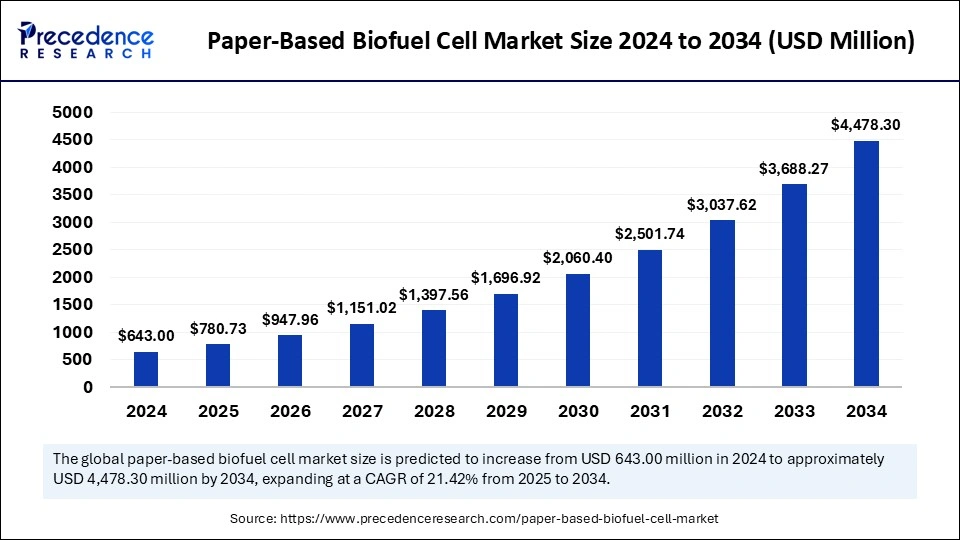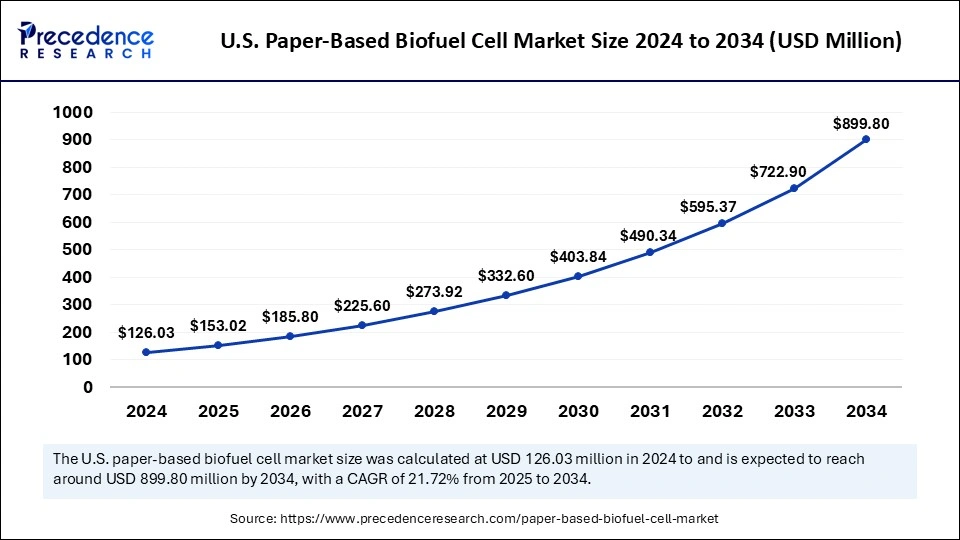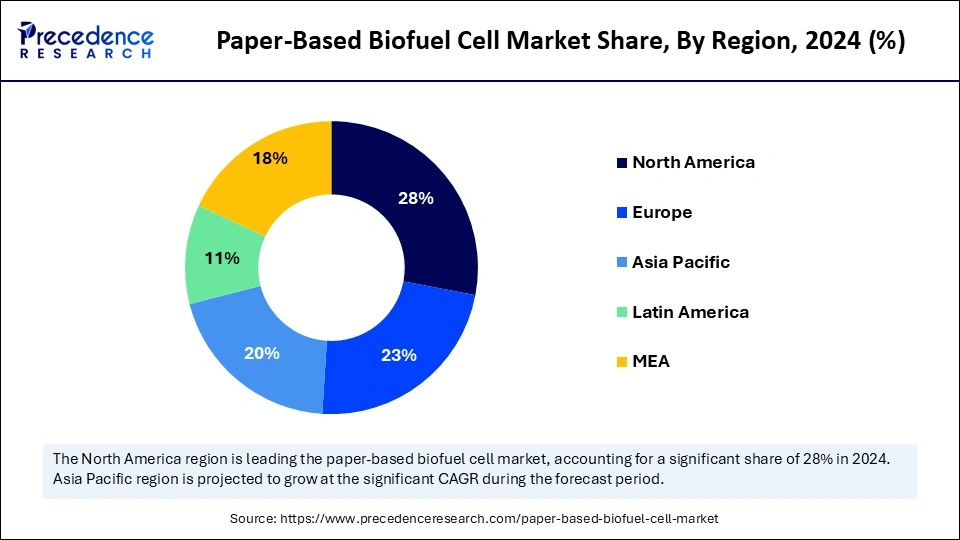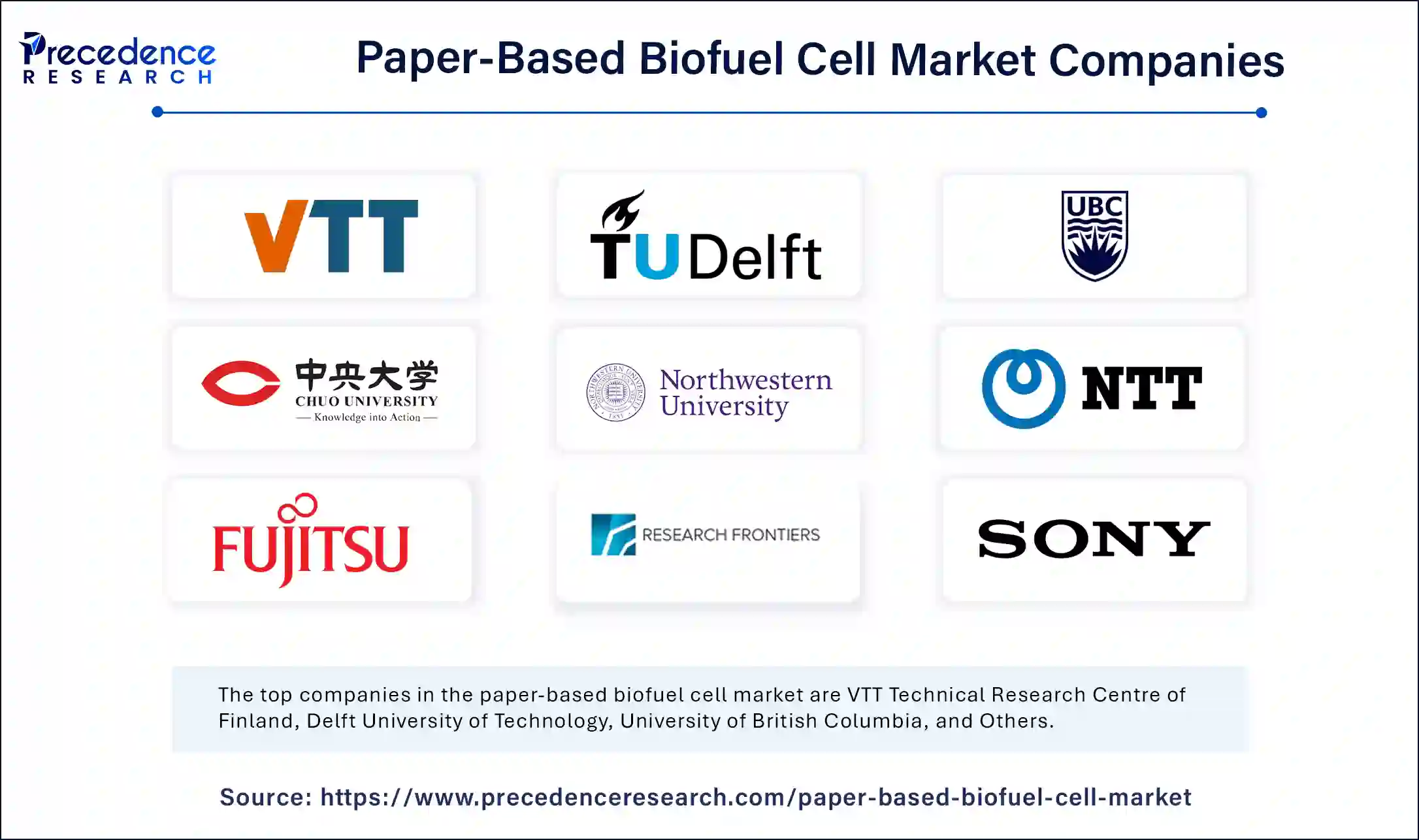January 2025
The global paper-based biofuel cell market size is calculated at USD 780.73 million in 2025 and is forecasted to reach around USD 4,478.30 million by 2034, accelerating at a CAGR of 21.42% from 2025 to 2034. The North America market size surpassed USD 180.04 million in 2024 and is expanding at a CAGR of 21.64% during the forecast period. The market sizing and forecasts are revenue-based (USD Million/Million), with 2024 as the base year.
The global paper-based biofuel cell market size was estimated at USD 643.00 million in 2024 and is predicted to increase from USD 780.73 million in 2025 to approximately USD 4,478.30 million by 2034, expanding at a CAGR of 21.42% from 2025 to 2034. The demand for sustainable energy solutions has increased, leading to driving the paper-based biofuel cells market. The adoption of advanced paper-based electrode technology shapes the market. The integration of smart sensors and electronic tags to harvest, monitor, and transmit data on various parameters such as temperature, humidity, and pH is surging for cutting-edge availabilities.

Integrating artificial intelligence with exciting technologies and devices in the paper-based biofuel cell market has been gaining popularity. AI is essential in improving efficiency and sustainability in the sector. AI algorithms play a crucial role in optimizing production processes and product quality, as well as reducing waste and cost. The recent advantages AI provides for paper-based biofuel cells are measuring generative data to improve fuel end-uses, bioenergy supply chain design, and optimizations. The surge of key manufacturing companies to develop standardizations for selective AI technology to improve data collection and documentation and its potential to enhance the sustainable development of bioenergy systems is transforming the importance of AI in the biofuel cell sector.
The U.S. paper-based biofuel cell market size was exhibited at USD 126.03 Million in 2024 and is projected to be worth around USD 899.80 Million by 2034, growing at a CAGR of 21.72% from 2025 to 2034.

North America dominated the paper-based biofuel cell market with the largest share in 2024 due to its well-established technology sector and expanding healthcare sector. The growing prevalence of lifestyle diseases in North America has been responsible for the rapid growth of the adoption of implanted medical devices and wearable devices. The growing regions concerned about the reduction of carbon emissions are drawing government and regulatory focus in the biofuel cell industry.
The United States is leading the North American market due to increased demand for wearable devices in the healthcare, automotive, military, and defense sectors of the nation. The presence of key landscapes, including Nissan Moto Corporation Ltd., Cambria Innovation Inc., and BeFc, is inspiring the company's biofuel industry.

Asia Pacific is the fastest-growing paper-based biofuel cell market during the forecast period due to the country’s vast research base in microbial fuel cells. Asia Pacific has gained a significant lead in the development of hybrid batteries in recent years. The government plays a crucial role in the innovation, development, and adoption of cutting-edge technologies in the country.
China is leading the Asia Pacific market mainly due to government investments and support for technological advancements. Sustainable solutions to reduce wastewater and energy are being crucially applied in China. Countries like India and Japan are contributing a significant share of the regional market. Increased demand for eco-friendly and renewable energy sources is driving the Indian market. On the other hand, Japan’s search for power-efficient solutions and the development of novel advanced technologies are emerging in the market.
Paper-based biofuel cells are sustainable and biodegradable fuel cells that help to reduce the need for critical raw materials and access to cost-effective solutions. The innovation, development, and adoption factors of paper-based biofuel cells are rising majorly due to growing concerns about organic fuels and eco-friendly energy sources. The paper-based biofuel cell market has been witnessing extreme growth due to various innovative developments in recent years, including cell generation by using glucose and oxygen to generate electricity to provide a sustainable alternative to traditional miniature batteries.
Several factors, such as advances in paper-based electrode fabrications, integration into wearable devices, growing recyclable and biodegradability concerns, and strategic partnerships and collaborations between government, key companies, and research institutions, are leveraging strategic approaches in innovation and developments of paper-based biofuel cells. Additionally, with growing government investments in R&D due to increased concern about environmental and biodegradability issues, there is a surge in the development of innovative solutions.
The paper-based biofuel cell industry faces various challenges, such as Limited power outputs, stability, durability, and risk of cross-contamination in enzymatic biofuel cells. However, ongoing research and developments of flexible and transparent biofuel cells, integration with nanomaterials, and developments of wireless power transmissions by using paper-based biofuel cells are transforming the efficiency, cost-effectiveness, durability, and performance of paper-based biofuel cells.
| Report Coverage | Details |
| Market Size by 2034 | USD 4,478.30 Million |
| Market Size in 2025 | USD 780.73 Million |
| Market Size in 2024 | USD 643.00 Million |
| Market Growth Rate from 2025 to 2034 | CAGR of 21.42% |
| Dominating Region | North America |
| Fastest Growing Region | Asia Pacific |
| Base Year | 2024 |
| Forecast Period | 2025 to 2034 |
| Segments Covered | Technology, Component, Application, End-Use, and Regions. |
| Regions Covered | North America, Europe, Asia-Pacific, Latin America, and Middle East & Africa. |
Environmental Sustainability
The growing concerns about environmental sustainability are driving the development of innovative biofuel technologies, including in the paper-based biofuel cell market. Environmental regulatory bodies are pressured to step toward the reduction of carbon footprints, driving demand for renewable energy sources and biodegradable, recyclable packaging solutions. The growing emphasis on sustainability reduces reliance on fossil fuels, making it essential for the innovation and development of biofuel cells. Paper-based biofuel cells deliver less carbon emission compared to fossil fuel-based power sources. Growing consumer awareness of eco-friendly and biodegradable energy sources is contributing to the market expansion. Reduction of carbon footprints and cost-effectiveness are the major factors boosting the adoption of paper-based biofuel cell solutions.
Stability and durability
There are concerns for the long-term scalability and durability of paper-based biofuel cell market solutions. Paper-based biofuel cells are unstable to chemicals, moisture, and temperature, which impacts their performance and stability. Paper-based biofuel cells have a limited lifespan, hampering the adoption rate. Additionally, mechanical complications and corrosion risks make them least preferred by end-users. However, ongoing innovation and developments in technology to improve their stability and durability are likely to draw novel approaches.
Advancements in paper-based electrode technology
Technological advancements are a significant trend for the emerging paper-based biofuel cell market. A growing emphasis on improving the stability, reliability, and durability of paper-based biofuel cells has surged in advancements of paper-based electrode technology. Paper-based electrode technology helps to improve the durability of biofuel cells to maintain them in harsh environments with extended lifespans. Advanced electrode technology allows improved conductivity in paper-based biofuel cells to enhance their efficiency and performance. Additionally, the increased surface area due to the leverage of advanced electrode technology improves electrochemical reactions entered to enhance stability and performance. The integration of advanced electrode technology provides various advantages to paper-based biofuel cells by improving their efficiency, application capabilities, durability, stability, flexibility, and cost-effectiveness.
By technology, the enzymatic fuel cells segment held a major paper-based biofuel cell market share in 2024. Enzymatic fuel cells are poured to high power density compared to conventional microbial fuel cells. Enzymatic fuel cells are high-energy, energy-efficient, paper-based biofuel cells. Enzymatic fuel cells are ideal for wearable devices and implantable medical devices, making them a priority for consumer electronics and healthcare applications. Additionally, the high utilization of enzymatic fuel cells for portable electronics such as laptops and smartphones highly contributes to segment growth.
On the other hand, the microbial fuel cells segment will witness notable growth in the forecast period. The segment growth is attributed to their ideal applications in the energy sector. Microbial fuel cells are majorly used in wastewater treatments, bioremediation, and powering small devices. The ability of microbial fuel cells to provide high energy efficiency along with cost-effectiveness makes them the ideal technology for paper-based biofuel cells.
By component, the paper substrate segment dominated the global paper-based biofuel cell market in 2024 due to its lightweight and biodegradable properties. Paper substrates have high porosity, which enables efficient mass transport. The disposable and wearable devices are significant for the demand for paper substrate biofuel cells. Paper substrate materials are cost-effective compared to other components. Paper substrate components are essential in paper-based biosensors and enzymatic fuel cells to generate electricity from organic components like paper sensors.
The catalyst segment is projected to grow rapidly over the forecast period. Catalyst components are highly utilized to improve the performance of fuel cells. Catalyst enhances the efficiency of biofuel cells. Catalysts, including enzymes, nanomaterials, and metal-organic frameworks, are ideal for paper-based biofuel cells to speed up their chemical reactions and convert them into biofuels into electrical energy under mild conditions, improve efficiency, and improve performance.
By application, the portable electronic devices segment held a major paper-based biofuel cell market share in 2024. The increased demand for sustainable and renewable energy sources is the major factor driving the growth and adoption of portable electronic devices. The increased adoption of portable electronic devices, laptops, tablets, smartphones, drones, and fitness trackers is a major driving demand for eco-friendly and energy-efficient sources like paper-based biofuel cells.
The wearable technology segment will show significant growth in the forecast period due to increased demand for sustainable and renewable energy sources for wearable devices. The adoption of wearable devices like smartwatches, fitness trackers, and sensors is high, making it essential for the leverage of sustainable source solutions. The growing emphasis on sustainable energy solutions and advancements in electrode technology allows the development of paper-based biofuel cells for wearable devices.
By end use, the consumer electronics segment led the global paper-based biofuel cell market in 2024. The segment growth is accounted for due to increased consumer awareness of sustainability and carbon emissions. The increased demand for energy-efficient and sustainable source solutions is driving the adoption of paper-based biofuel cells in consumer electronics such as smartphones, tablets, wearable devices, and portable electronics. The growing commitment of manufacturing companies to comply with consumer demands is surging further innovations and developments in paper-based biofuel cells
However, the industrial applications segment is expected to witness significant growth in the forecast period. Government and regulatory pressure for the utilization of sustainable and reducing carbon footprint sources is driving influence on the segment expansion. The growing demand for lightweight, minimal environmental impact, and easily disposable portable power alternatives is shifting industries to the adoption of paper-based biofuel cells. Additionally, the high demand for wastewater treatment, power generation sources, and medications in industrial areas is opening the way for the entry of paper-based biofuel cells into the industries.

By Technology
By Component
By Application
By End-Use
By Geography
For inquiries regarding discounts, bulk purchases, or customization requests, please contact us at sales@precedenceresearch.com
No cookie-cutter, only authentic analysis – take the 1st step to become a Precedence Research client
January 2025
December 2024
December 2024
October 2023